Spirit Work: Blessed Virgin of the Bright Hill
Spirit Work: The Black Madonna of Czestochowa
Spirit Work: Erzulie Dantor/Ezili Danto/Mambo Ezili Danto
Spirit Work: Oya as Santa Barbara Africana/Saint Barbara Lucumi
Believe it or not these “spirits” are all related through a specific Black Madonna image. Anyone is welcome to use the links to jump down to a particular subheading.
|
The Black Madonna of Czestochowa
The Madonna of Czestochowa is also known as the “Najswietsza Maryja Panna z Jasnej Gory” (the Blessed Virgin Mary from Jasna Gora)--or as the Blessed Virgin of the Bright Hill/Luminus Mount/Illuminated Hill.
Jasna Gora ("bright hill")-—in Latin, Clarus Mons--is a sanctuary located on the Jasna Gora hill in south Poland. With more than five million visitors each year, it is one the largest pilgrimage sites of Marian devotion in the world. The miraculous image of the Madonna of Czestochowa is enshrined in the Basilica of the Jasna Gora monastery complex of the Pauline Order in Czestochowa.
Many legends and miracles are associated with this icon—more than are mentioned here.
According to legend, the image of the Blessed Virgin of the Bright Hill was painted by the evangelist Saint Luke. She is a Black Madonna.
In Constantinople, Constantine the Great, the first Christian Emperor of Rome, built a chapel for the portrait--as the legend also claims--where it remained for five centuries. Eventually, this miraculous image was taken to Kiev and installed in the Royal Palace of Belz.
In 1392, the image was damaged by invading Tartars. An arrow pierced the miraculous image, leaving a scar that is still visible on the neck of the Madonna. Concerned for the safety of the image of the Madonna, Prince Ladislaus Opolski decided to move the icon elsewhere.
During the journey, the wagon transporting the image stopped at a place called “Jasna Gora” (Bright Hill) near the town of Czestochowa—and the horses refused to move. No amount of coaxing or goading could make them go on. It is said that the Madonna appeared to Ladislaus and informed the prince that this place was where she would reside. He gave the image for safekeeping into the care of the Basilian monks of the Greek Rite who placed it in a small chapel. (There is more than one version of this legend about how the image ended up at Jasna Gora.)
|
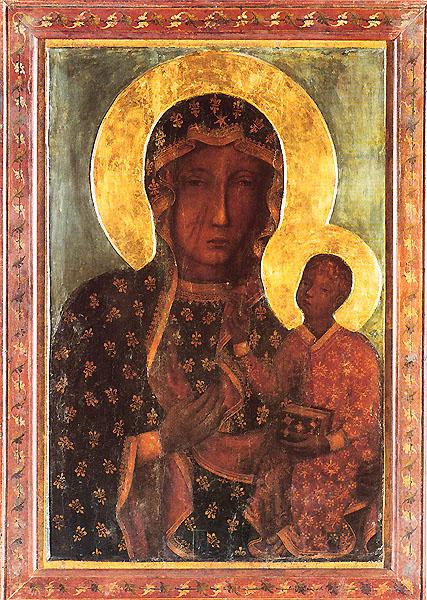 |
JPEG image of the original painting of the Black
Madonna of Czestochowa. Both the Madonna and Child
are dark skinned. Note the Madonna has two scars on
the right cheek from when this miraculous image was
damaged, but not destroyed.
|
|
A few years later, Prince Ladislaus returned and founded the Pauline monastery and church on the same site, to house the miraculous image the of the Blessed Virgin, entrusting its care to the monks of the Latin Rite Hermits of Saint Paul.
In 1439, the Protestant Hussites attacked and looted the monastery, attempting to steal the image. It is said that the marks on the cheek of the face of Black Madonna occurred when a man struck the image with his saber. According to the story, after the man slashed at the image twice and when he rasied his blade for a third time, he fell to the ground writing in pain and died.
The walled monastery--during wars in Poland--served as a military center. Though it was attacked in 1655, the 300 men defending the monastery routed the 12,000 men of the Swedish forces. The following year, Our Lady of Czestochowa was declared as the patroness of the country.
On September 16, 1994, the Jasna Gora Monastery was named a Pomnik Historii, one of Poland's national Historic Monuments.
Many copies of this miraculous image have been created.
In honoring Our Lady, Catholics want to have her image as beautiful as possible, so artists who portray her miraculous images tend to fancy up the details a bit, so that is why you will find various versions of Our Lady's miraculous images, from Our Lady of Pompei to Our Lady of Guadalupe. For the Polish people, Our Lady of Czestochowa is Queen of their country and she is now adorned as royal images are often depicted, but most especially because the Roman Pontiff presented her with this Crown of which you are viewing a replica. There is nothing sinister or harmful to Our Lady with this intention, it is just human nature and quite touching actually. “ -- Our Lady of Czestochowa History of the Image
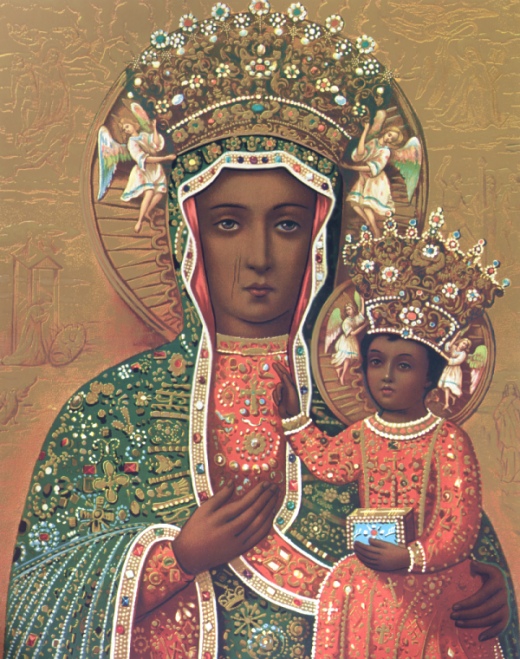
These two somewhat different images are
both copies for the faithful of the
Black Madonna of Czestochowa.
I actually have a copy of this image,
which I purchased from a gift shop at
a Catholic shrine in Florida, hanging
in a frame on my wall.
|
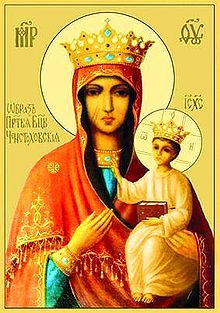
Imago thaumaturga Beatae Virginis
Mariae Immaculatae Conceptae
(Wonderworking Image Blessed Virgin
Mary of the Immaculate Conception), this
Eastern Orthodox icon, which is a copy of
the famous Our Lady of Czestochowa,
also includes the two marks on her cheek. |
Many of her devotees display or carry a copy of this image of the Madonna, the mother of the Lord and Savior.
Erzulie Dantor/Ezili Danto/Mambo Ezili Danto...as well as Ezili Dantor
The lwa Erzulie Dantor/Ezili Danto/Mambo Ezili Danto is venerated in both Haitian Vodou and New Orleans Voodoo. Erzulie Dantor is a powerful Petro lwa.
She is most commonly represented by The Black Madonna of Czestochowa. The image that was supposedly brought to Haiti by the polish military forces sent by Napoleon [Bonaparte] in hopes of suppressing the Haitian revolution.”
….
She is best known for her blessings that concerns healing, motherhood, protection from violence, lesbians, homosexuals, wealth, strength, vengeance and single women. If you are planning on worshiping the lwa of motherhood.
---Voodoo Priest Man, Who Is Erzulie Dantor In Haitian Vodou? 2017, accessed 10/11/18.
Erzulie Dantor is syncretized to the Black Madonna of Czestochowa. Polish soldiers brought copies of the miraclous image to Haiti. The marks on the cheek of the image resembled African tribal marks. In NOLA Voodoo (New Orleans, LA, Voodoo) Erzulie Dantor is sometimes also connected to the images of Our Lady of Prompt Succor, Our Lady of Perpetual Help, and Our Lady of Lourdes.
Dantor is served with the Image of Mater Salvatoris, sometimes also known as Santa Barbara Africana, which is the image you see on the top left hand corner of this page. She is also associated with other Madonnas who hold a child such as Our Lady of Mount Carmel and Our Lady of Czestochowa. Other images include Our Lady of Lourdes and Our Lady of Perpetual Help.
….
Danto is also considered a protector of children. As naturally as a mother would protect her own, Mama Danto will always go to extremes to ensure the safety of her children.
--Papa Hector, Ezili Danto, Mambo Ezili Danto (aka Erzulie Dantor) 2017, accessed 10/11/18.
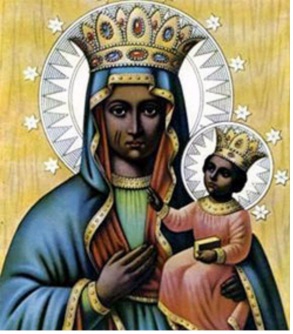 |
This image is known as Mater
Salvatoris, the Blessed Virgin
Mary as the "Mother of Our Savior."
The Madonna's right hand points
towards her child. This image is
adapted from the Black Madonna of
Czestochowa.
It is popularly used to represent
in Haitian Vodou Erzulie Dantor
and in Dominican Vudu Ezili Dantor.
It is sometimes sold on candles
in botanicas under the name:
Santa Barbara Africana. |
|
The image of the Black Madonna of Czestochowa was brought by the solidiers in the Polish legions sent to assist Napoleon Bonaparte to suppress the Haitian Revolution for Independence. Appalled by the slavery they witnessed, many Polish soldiers mutinied and switched sides.
In Haitian Vodou, Erzulie Dantor is strongly associated with the legends surrounding Bois Caimon and the Haitian revolution for independence.
In the Spanish speaking Dominican Republic, Ezili Dantor is syncretized to Santa Barbara Africana in the practice of Dominican Vudu, Las 21 Divisiones.
In Haiti, Erzulie Dantor is a powerful guardian for those she considers under her protection—which includes single mothers, working women, and female soldiers. She also aids lesbians, merchants, women working in the market, women striving to become financially independent and provide for their children.
I have heard that single mothers will appeal to her for help with child custody cases and back due child support. Devotees offer her cooked pork, pineapples, corn, cornbread, corn muffins, pepper jelly, cinamon/cayenne pepper sprinkled into honey, and Florida water. Her special days are Tuesday and Saturday.
In July, the city of New Orleans, LA (NOLA), has a tradition of petitioning the Voodoo lwa Erzulie Dantor as well as the Catholic Madonna under her titles as Our Lady of Prompt Succor, Our Lady of Perpetual Help, and Our Lady of Lourdes for protection from huricanes. I imagine that could include use of the image of Our Lady of Czestochowa as another representation of the Madonna.
I also know that in other parts of the USA--as well as in multicultural, mulitfaithed NOLA--there is a tradition of petitioning the Voodoo lwa Erzulie Dantor as well as the Catholic Madonna either with the image of the Black Madonna and/or under the titles of Our Lady of Perpetual Help or Our Lady of Prompt Succor for protection against tropical storms and huricanes.
If an individual petitions Erzulie Dantor for aid, it is appropriate to create a small home altar to her with an appropriate image, candle, knife, and some suitable offerings.
|
Oya as Santa Barbara Africana/Santa Barbara Lucumi
Oya is the orisha of winds, lightning, violent storms, and hurricanes. Thus, Oya can be petitioned for protection during this sort of violent weather.
Images of Our Lady of Czestochowa are sold on candles labeled “Santa Barbara Africana, Santa Barbara Lucumi," with Spanish prayers.
In Cuba, Oya is syncretized to the image of Our Lady of Carmen, the Virgin of Candelaria, and Santa Teresa de Jesus. In Venezuela, Oya is syncretized to Santa Barbara Africana. While the orisha Shango (Oya's consort) is syncretized to Santa Barbara Shango.
In an article, Santa Barbara Lucumí, Tus preguntas sobre los Santos,, April 12, 2010, someone wondered why Santa Barbara Lucumi is represented with the image of Our Lady of Czestochowa. A translation of the question and answer is below:
|
I found an image of Santa Barbara…or Santa Barbara Lucumi (of the Santería religion also known as Lucumi). However Santa Barbara Lucumi is represented with the image of Our Lady of Czestochowa…but why?
[Encontre una imagen de Santa Barbara.. o Santa Barbara Lucumi (de la religion Santera) Pero se le representa con la imagen de Nuestra Senora de Czestochowa.. esto porque?]
It is obvious that they have used the image first black Madonna they have found and said, "If she is black, she is African, therefore, it is Santa Barbara Lucumí". (Se ve que han usado la primera virgen negra que han hallado y han dicho, "si es negra, es africana, por tanto, es Santa Barbara Lucumí".)
-- Santa Barbara Lucumí, Tus preguntas sobre los Santos,
, April 12, 2010, accessed 10/11/18.
|
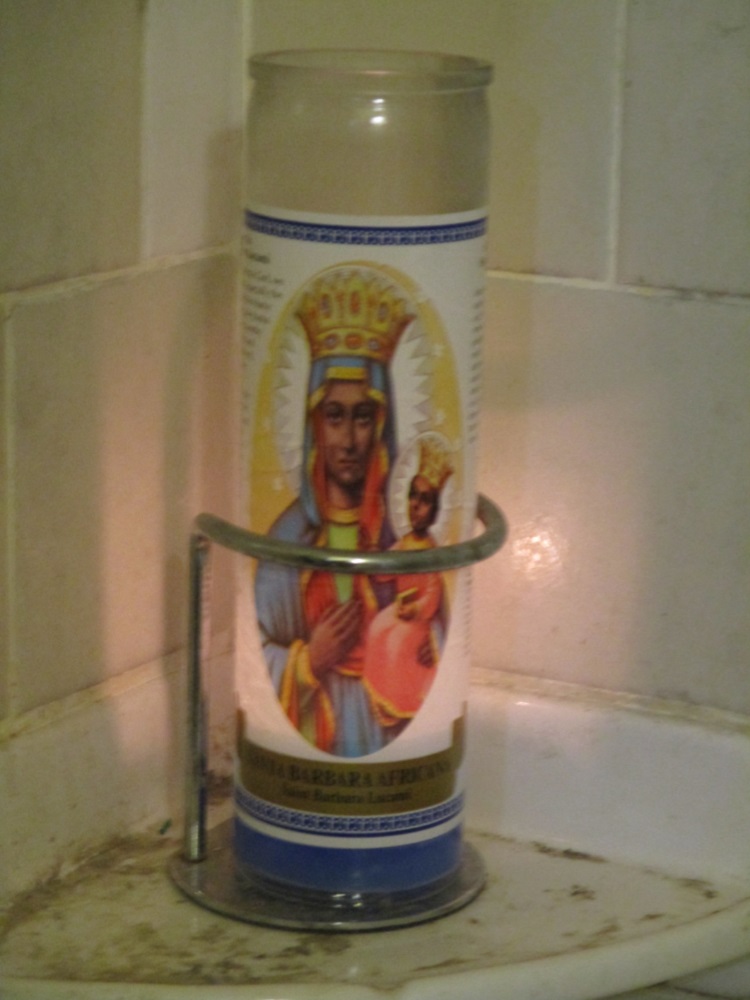
Photo by Myth Woodling 10/11/18.
The image on the candle is labeled Santa Barbara Africana, Santa Barbara Lucumi.
|
This explanation is a reasonable speculation about how Oya may have become syncretized with this image. The orisha, Oya, is most often visualized as a dark skinned African woman.
Oya Yansa is often perceived as a muscular black African wearing a full skirt made up of nine different pieces of cloth. Oya's skirt swirls while she is dancing in the storms.
Oya's day of the week is Friday, which is the day when she hands out punishment for anyone who has disrespected her. She's syncretized in the Catholic religion with the Virgin of Candelaria, the Virgin of Carmen, and in some parts of Cuba with Santa Teresa de Jesus. In Cuba, her feast day is normally celebrated on February 2, which is the feast day of the Candelaria.
-- Cynthia Duncan,
Oya, The Owner of the Wind, AboutSanteria (I cannot find a date for this article) accessed 10/11/18.
Oya will aid women warriors, equestrians, librarians, and spirit mediums. She rules over the cemetery and market place. Thus, she also favors female merchants and shopkeepers, as well as cemetery workers and morticians.
I have also heard that Oya is sometimes petitioned in child custody cases with a purple eggplant left at a cemetery.
If an individual petitions Oya for aid, a small home altar may be created for her with a representation of a lightning bolt, antelope/water buffalo horns, two swords/machette and a horse tail fly wisk, and nine water-worn river pebbles. Since she rules over the cemetery, an individual can leave her offerings by the cemetery gate.
What does this mean?
My point is three different female “spirits” are associated with the miraculous image of Our Lady of Czestochowa, the Black Madonna.
In her excellent book, Encyclopedia of Mystics, Saints, and Sages: A Guide to Asking Protection, Wealth, Happiness, and Everything Else!, 2011, Judika Illes wrote: "Those unfamiliar with the various syncretic traditions tend to treat Santa Barbara Africana as if she were a Madonna." p. 168.
Though some practitioners of hoodoo will work with many sundry spirits—including the lwa and/or the orishas—others do not. The focus of "That Hoodoo..." website is primarily upon USA hoodoo practice rather than other forms of African Diaspora religions. Some practitioners of hoodoo/conjure/root work instead primarily use biblical scripture and prayers.
Practitioners dwelling in predominately Protestant areas—if they engage in spirit work at all—generally call only upon biblical figures and angels.
Practitioners dwelling in predominantly Catholic areas, will call upon various saints, angels, some biblical figures, and most definitely the Madonna.
As Catholics believe that any Christian may call upon the Madonna under any title, I have included the following prayers below. (See Prayers.)
In New Orleans, LA, there is a tradition that Erzulie Dantor is petitioned for protection from hurricanes.
In Santeria, Oya can be petitioned for protection against lighting, hurricanes, tornados, and storms.
Those practitioners who are—or wish to be—devotees of either Erzulie Dantor or Oya using the image of the Black Madonna of Czestochowa should approach either the lwa OR the orisha by setting an altar with a prayer card or image of the Black Madonna, along with the correct offerings, colors, chants, symbols, etc. (I urge anyone doing so to read more about the spirit who is being approached and what is the proper veneration in the correct Afro-Carribean religion.
These two spirits should NOT be honored together on any home altar. Erzulie Dantor and Oya are not syncretized to each other.
I am fairly certain that any one particular individual ought NOT to be petitioning them both--even separately--for protection from the same storm or other danger.
The only reason that I have mentioned them both on this page is because of the connection to the image of the Black Madonna of Czestochowa, the Blessed Virgin of the Bright Hill.
Prayers: Blessed Virgin of the Bright Hill/Our Lady of Czestochawa
Prayer of Petition to Our Lady of Jasna Gora
In dangers threatening your people:
Be our help and our protection, O Lady of Jasna Gora!
In our constant concern for preserving the Catholic heritage:
Be our help and our protection, O Lady of Jasna Gora!
In our efforts to keep faithful to God, to the Cross and to the Gospel:
Be our help and our protection, O Lady of Jasna Gora!
In danger of succumbing to evil habits:
Be our help and our protection, O Lady of Jasna Gora!
When we are oppressed by doubts and temptations against faith:
Be our help and our protection, O Lady of Jasna Gora!
When we feel lonely and abandoned:
Be our help and our protection, O Lady of Jasna Gora!
[state petitions]
O Mother with the Divine Infant in your arms, through your sacred image you remind us of the constant presence of your Child and your motherly solicitude as a source of strength and courage in our daily trials, difficulties and labors. Strengthen us in our faith and obtain for us the power to renew our lives in the spirit of God's commandments and the Gospels of Christ. Amen.
It is to you, O holy Mother of God that we go for refuge and protection. Look kindly on us as we cry to you in our need. Glorious and blessed Virgin, be with us always and rescue us from every kind of danger. Amen.
Lady of Jasna Gora Prayer
Lady of Jasna Gora, our Mother, trusting in your maternal goodness and powerful intercession with your Son, we place before you our humble prayers and petitions. To you we commend all our needs.
[state petitions]
O Lady of Jasna Gora, may all who venerate you, feel now your help and intercession. Make it your continual care to pray for the people of God, for you were blessed by God and were made worthy to bear the Redeemer of the world, who lives and reigns for ever. Amen.
Prayer to Our Lady of Czestochowa, the Black Virgin
(to be said upon arising from sleep)
Holy Mother of Czestochowa, you are full of grace, goodness, and mercy. I consecrate to you all my thoughts, words, and actions, my soul and body. I beseech your blessings and especially prayers for my protection and salvation. [state petition] Today, I consecrate myself to you, Good Mother, totally, with body and soul amid joy and sufferings to obtain for myself and others your blessing upon this earth--and eternal life in heaven. Amen.
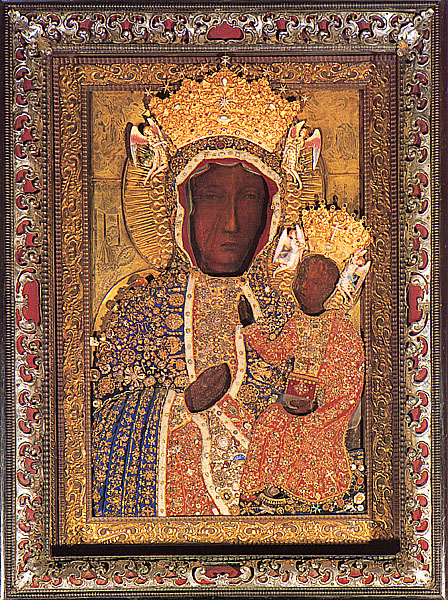 |
|
Current Oklad Cover |
This is the current oklad for Our Lady of
Czestochowa. An oklad covers up most of a
religious icon, except for certain parts,
such as faces and hands to protect the image.
Each oklad is unique and is made by hand for
a specific icon. In theory, the oklad can help
protect the image from damage or fading by
sunlight. The materials used are symbolic.
Gold represents God's grace, silver for
purity, etc.
|
Sources:
Our Lady of Czestochowa History of the Image accessed 10/11/18.
Christine Barrely, The Little Book of Mary, 2012.
Voodoo Priest Man, Who Is Erzulie Dantor In Haitian Vodou? 2017, accessed 10/11/18.
Papa Hector, Ezili Danto, Mambo Ezili Danto (aka Erzulie Dantor) 2017, accessed 10/11/18.
D. Theard, with A. Pustanio, Sallie Ann Glassman New Orleans Voodoo Ritual for Hurricane Protection - Hurricane Protection Ritual Honoring Erzulie Dantor and Our Lady of Prompt Succor, 2006-2009, accessed 10/11/18.
Santa Barbara Lucumí, Tus preguntas sobre los Santos,,, April 12, 2010, accessed 10/11/18.
Cynthia Duncan,
Oya, The Owner of the Wind, AboutSanteria (I cannot find a date for this article) accessed 10/11/18.
Judika Illes, The Encyclopedia of Spirits: The Ultimate Guide to the Magic of Fairies, Demons, Ghosts, Gods and Goddesses, 2009.
Judika Illes, Encyclopedia of Mystics, Saints, and Sages: A Guide to Asking Protection, Wealth, Happiness, and Everything Else!, 2011.
Category: Oya, AIRR- Association of Independent Readers and Rootworkers June 20, 2017, accessed 10/11/18.
Category: Erzuli Dantor, AIRR- Association of Independent Readers and Rootworkers December 4, 2012, accessed 10/11/18.
Original Painting of Our Lady of Czestochowa J-Peg.
Joe Nickell, The Black Madonna: A Folkloristic and Iconographic Investigation – Skeptical Inquirer — Volume 39.5
,September/October 2015--written by noted skeptic, Joe Nickell, this article discusses several legends about the icon; accessed 10/11/2018.
Spirit Work
"That Hoodoo..." home page
Useful Prayers: Hurricane Prayer
Comparing the Legends of Bois Caiman, Who says we don't want to talk about it?





